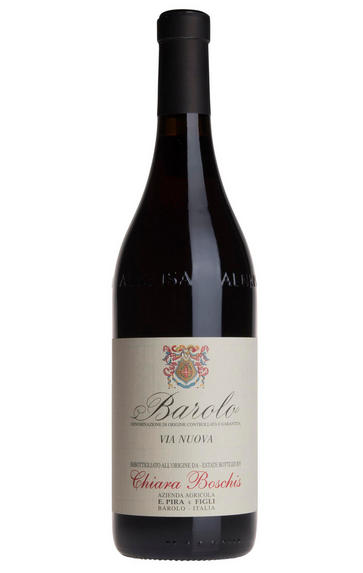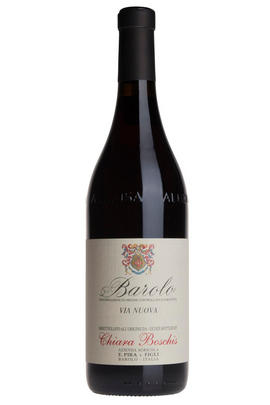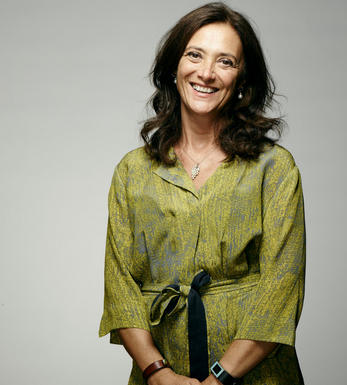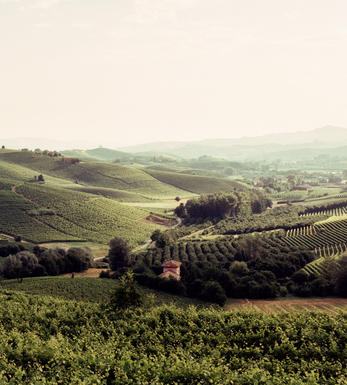
2005 Barolo, Via Nuova, E. Pira di Chiara Boschis, Piedmont, Italy

Critics reviews
The always energetic Chiara Boschis is among the producers who did quite well in 2005. Boschis gave her 2005 Barolos 70% new oak, down from the 100% that was once the norm, and the wines show greater purity and integrity of fruit. Her vineyards in Cannubi, one of Barolo’s warmest sites, were well positioned (literally) to deal with the cooler vintage. In the higher-altitude, fresher Via Nuova, she took yields down a bit lower than normal to give the fruit the best chance to ripen. The proof is in the glass, and these are two exceptionally beautiful 2005 Barolos (Antonio Galloni - Wine Advocate - Oct 08)
(Tamlyn Currin - jancisrobinson.com - 25 Mar 2010)
About this WINE

E.Pira di Chiara Boschis, Piedmont
Since its purchase in 1980, following the tragic death of Luigi Pira, last in line of this historic family, Chiara Boschis di E. Pira has now grown this jewel of Barolo wine estate to 8.5ha/35,000 bts/ 50% of it, Nebbiolo. The estate is, like her, in perpetual motion and evolution. Since her brother Giorgio joined her a couple of years back, having left Borgogno, they’ve added new vineyards in Monforte d’Alba and started renting a plot in Serralunga’s Gabutti.
The twin pillars of the (wine) estate are the vineyards Cannubi & Via Nuova. Cannubi, facing SW, is Barolo's legendary cru of which Chiara has a fair few rows. Cannubi should not be confused with the likes of Cannubi Boschis or Cannubi Muscatel. There’s been the addition of new French (Vicard) oak botte grande, and consequently marginally fewer new barriques bought, plus a new storage ‘bunker’ at their Barolo cantina.
Her petite SSE-facing Via Nuova site located just up behind the winery was documented as far back as 1904, flanking the then new path to Novello; its vines are younger though, at 16 years. The modern vinification, carried out in a recently renovated cantina, is tightly controlled and constantly checked, with Chiara a keen analyst. Hulking rotofermentors still dominate the diminuitive cellar, though perhaps they're less frenetic than in the past.
She’s still tending her cows in Castelmagno for their cheese, or should I say her other brother Cesare is, and in 2013 she added a new Barolo to the offer: Mosconi, a prodigious single vineyard Barolo from the village of Monforte d’Alba.
Chiara's infectious energy, her can-do, will-do approach to life is reflected in her wines, which are constantly evolving she says, albeit incrementally. What doesn't alter, fortunately, is her staunch belief that the vineyards are sacred; a virtue which shines through in the deliciously seductive, compelling wines. A modern producer of Barolo who’s on the right tracks.
David Berry Green, BBR Buyer

Barolo
Located due south of Alba and the River Tanaro, Barolo is Piedmont's most famous wine DOCG (Denominazione di Origine Controllata e Garantita), renowned for producing Italy's finest red wines from 100 percent Nebbiolo.
Its red wines were originally sweet, but in 1840 the then extant Italian monarchy, the House of Savoy, ordered them to be altered to a dry style. This project was realised by French oenologist Louis Oudart, whose experience with Pinot Noir had convinced him of Nebbiolo's potential. The Barolo appellation was formalised in 1966 at around 1,700 hectares – only a tenth of the size of Burgundy, but almost three times as big as neighbouring Barbaresco.
Upgraded to DOCG status in 1980, Barolo comprises two distinct soil types: the first is a Tortonian sandy marl that produces a more feminine style of wine and can be found in the villages of Barolo, La Morra, Cherasco, Verduno, Novello, Roddi and parts of Castiglione Falletto. The second is the older Helvetian sandstone clay that bestows the wines with a more muscular style. This can be found in Monforte d'Alba, Serralunga d'Alba, Diano d'Alba, Grinzane Cavour and the other parts of Castiglione Falletto. Made today from the Nebbiolo clones Lampia, Michet and Rosé, Barolo has an exceptional terroir with almost every village perched on its own hill. The climate is continental, with an extended summer and autumn enabling the fickle Nebbiolo to achieve perfect ripeness.
Inspired by the success of modernists such as Elio Altare, there has been pressure in recent years to reduce the ageing requirements for Barolo; this has mostly been driven by new producers to the region, often with no Piedmontese viticultural heritage and armed with their roto-fermenters and barriques, intent on making a fruitier, more modern style of wine.
This modern style arguably appeals more to the important American market and its scribes, but the traditionalists continue to argue in favour of making Barolo in the classic way. They make the wine in a mix of epoxy-lined cement or stainless-steel cuves, followed by extended ageing in 25-hectoliter Slavonian botte (barrels) to gently soften and integrate the tannins. However, even amongst the traditionalists there has been a move, since the mid-1990s, towards using physiologically (rather than polyphenolically) riper fruit, aided by global warming. Both modernist and traditional schools can produce exceptional or disappointing wines.
Recommended traditionalist producers:
Giacomo Borgogno, Giacomo Conterno, Bruno Giacosa, Elio Grasso, Marcarini, Bartolo Mascarello and Giuseppe Mascarello.
Recommended nmdernist producers:
Azelia, Aldo Conterno, Luciano Sandrone, Paolo Scavino and Roberto Voerzio

Nebbiolo
Nebbiolo is the grape behind the Barolo and Barbaresco wines and is hardly ever seen outside the confines of Piedmont. It takes its name from "nebbia" which is Italian for fog, a frequent phenomenon in the region.
A notoriously pernickety grape, it requires sheltered south-facing sites and performs best on the well-drained calcareous marls to the north and south of Alba in the DOCG zones of Barbaresco and Barolo.
Langhe Nebbiolo is effectively the ‘second wine’ of Piedmont’s great Barolo & Barbarescos. This DOC is the only way Langhe producers can declassify their Barolo or Barbaresco fruit or wines to make an early-drinking style. Unlike Nebbiolo d’Alba, Langhe Nebbiolo can be cut with 15% other red indigenous varieties, such as Barbera or Dolcetto.
Nebbiolo flowers early and ripens late, so a long hang time, producing high levels of sugar, acidity and tannins; the challenge being to harvest the fruit with these three elements ripe and in balance. The best Barolos and Barbarescos are perfumed with aromas of tar, rose, mint, chocolate, liquorice and truffles. They age brilliantly and the very best need ten years to show at their best.


Buying options
Add to wishlist
Description
Delicately perfumed notes of 'meriame' (a brilliant red wild cherry), refinement and freshness decorate the piece; while to taste one can just sense the beautiful purity of fruit, the life, more cherry stone, and juicy as only Barolo from Barolo can be. Chiara's rightly eased up on the oak in this vintage, only 30% new barriques, preserving the fruit's clarity and detail. Drinking now till 2018 in my view, along with some carne cruda.
(David Berry Green)
wine at a glance
Delivery and quality guarantee